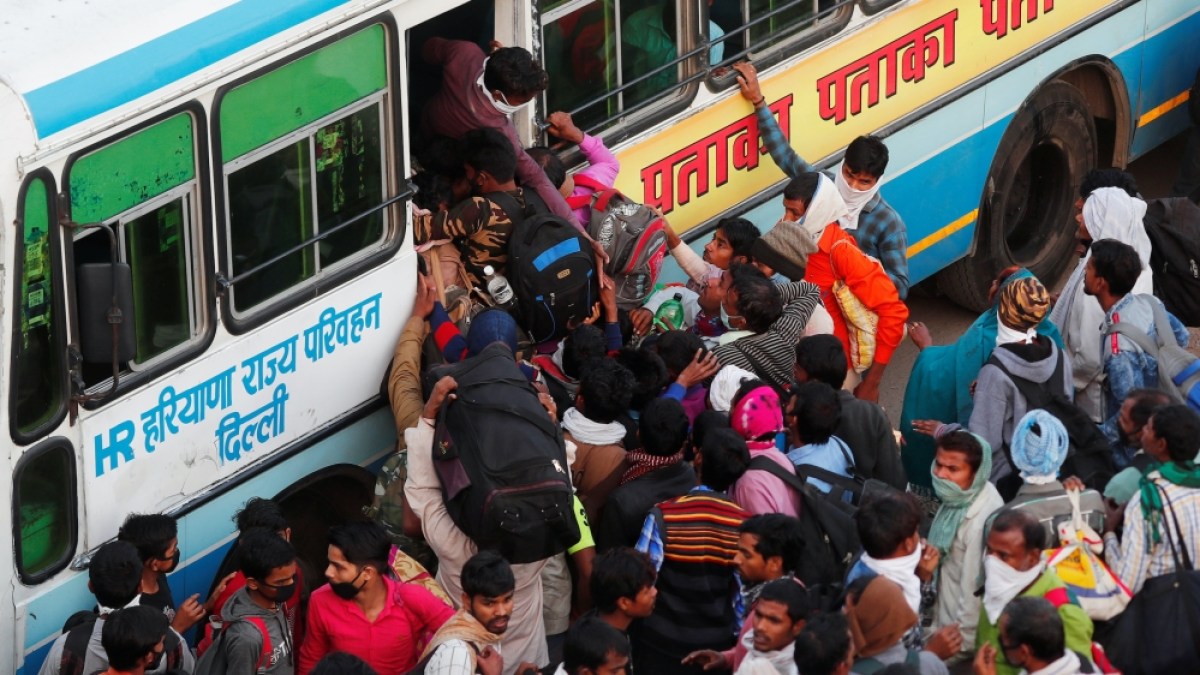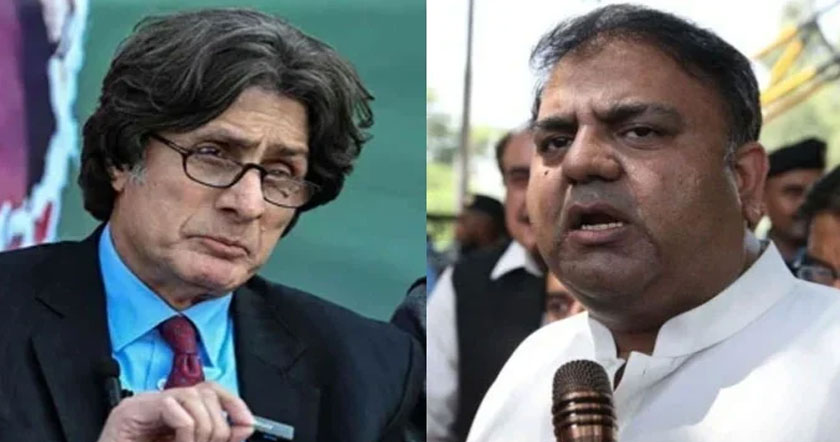Internal migrants form crucial part of India’s economy, but many say they have been forgotten in the coronavirus crisis.

Mumbai, India: Like many people under lockdown during the coronavirus pandemic, Pramod Sahu has been spending a lot of time on his phone to loved ones far away. But the 36-year-old laid-off textile worker in Surat, in India's western Gujarat state, is fast running out of money, food and options.
"I'm used to working 12 hours a day, but now I have nothing to do but sit here, stare at this screen and worry," he told Al Jazeera. "We're trying to make one person's food feed four, but right now I feel we will soon die of hunger," he said by phone from a cramped room he shares with eight other men.
Sahu is one of an estimated 100 million internal migrants in India. Travelling long distances from remote villages seeking work in India's bustling cities to support families they usually leave behind, they form a crucial lifeline for the economic wellbeing of hundreds of millions more,
According to the Indian government's 2016-17 Economic Survey, internal migrants make up about 20 percent of the workforce. And they contribute an estimated 10 percent of India's economic output, according to the UN Educational, Scientific and Cultural Organization.
But, without formal work contracts, they are vulnerable to exploitation and abuse. Many earn little more than a subsistence wage and have no social security to protect their incomes if they lose their jobs.
A growing number of aid agencies that help to support internal migrants fear the government's response to the coronavirus - which since March 24 has involved the closure of businesses and other public spaces - may lead to a humanitarian and economic disaster far larger than the medical emergency the measures are meant to control.
And economists say the government's recent economic stimulus measures are not nearly enough to mitigate the effects of the lockdown, especially for India's poor, including its internal migrants.
The lockdown has forced thousands of people like Sahu out onto urban streets. With most transport links shut down, many have been trying to walk the hundreds of kilometres back to their rural homes to ride out the crisis with their families.
Many of India's internal migrants travel from poorer states such as Bihar and Uttar Pradesh in the north to work in the industrial hubs of more developed states like Gujarat and Maharashtra in the south. Most do the low-paid or dangerous jobs that wealthier Indians refuse to do.
'Enormous' contribution to India's economy
"Their contribution to the economy is enormous," Jayati Ghosh, an economist at Jawaharlal Nehru University (JNU) in Delhi, told Al Jazeera. "But we don't actually know to what extent industries like construction and manufacturing comprise these workers".
Accurate data is hard to come by due to the group's high mobility and exclusion from official surveys.
But what is clear is that the money these workers send home is a key source of income for those they have left behind. In Odisha, for example, Sahu's home state, domestic remittances form 55-60 percent of annual incomes, according to a study by the Centre of Labour and Migration Studies.
The loss of this income threatens to worsen already precarious rural livelihoods, Nivedita Jayaram, a researcher at Aajeevika Bureau, a labour research and legal organization, told Al Jazeera.
"Just like in the cities, all work has stopped and people already can't afford to buy groceries, so there is a high risk of rural impoverishment increasing without these remittances," Jayaram said.
Though India currently has approximately 1,700 active coronavirus cases, Prime Minister Narendra Modi defended the lockdown's extreme measures as "absolutely necessary" in a radio address on Sunday, and asked for "forgiveness" for the hardships inflicted on his "poor countrymen".
But effectively halting the production of all goods and services, except some essential items, and enforcing a strict lockdown that keeps people indoors, and many out of work, comes at a high price for an already sluggish economy.
Growth in gross domestic product - the sum of all finished goods and services produced in a country - is currently at a six year-low, while India's unemployment rate is already at 7.8 percent, its highest since October 2019 according to the Centre for Monitoring the Indian Economy (CMIE).
"The lockdown is not just an attack on demand, but an attack on supply too, which is a problem for an economy in freefall," says JNU's Ghosh. "I fear that in order to prevent a catastrophe, they have created one."
While some analysts draw parallels to the economic disruption wrought by demonetisation in 2016 - when 80 percent of India's currency was taken out of circulation overnight - the long-term effects of the lockdown are already looking much worse, says Ghosh.
"The events are similar in the sense that policymakers now seem just as unprepared for the consequences as they were back then, and again the poorest are suffering - but at least during demonetisation not every part of the economy came to a grinding halt".
A political 'blindspot'
Though India's migrant labourers are significant in number, this group is a political "blindspot", Reetika Khera, an economist at the Indian Institute of Management Ahmedabad, told Al Jazeera.
"We should be setting up community kitchens and converting schools into welfare centres, but sadly our policymakers seem to be watching out more for the middle and upper classes," she said. "They clearly didn't anticipate any of this, and now everything feels like an afterthought".
The central government in New Delhi had asked regional states to prevent a migrant exodus by providing food and shelter, but too little time was given to implement this before the lockdown was imposed, "turning a public health crisis into a larger humanitarian one", says Aajeevika Bureau's Jayaram.
"While we warned overseas Indians in advance and chartered flights to bring them back home, we've left our internal migrants to fend for themselves," she said.
Under pressure to address the growing emergency, the central government last week announced a $23bn welfare scheme for the poor. This included doubling the amount of free food rations under an existing national programme, $10 to tide over senior citizens, and raising wages by $0.27 per day for those working under the government's rural employment scheme.
But analysts warn that this outlay of less than 1 percent of GDP, is not enough to stem the crisis and is mostly a "repackaging" of existing schemes.
"The increase to the [rural employment scheme] was notified a couple days before, so it's not new - and anyway worksites are currently shut," notes the Indian Institute of Management Ahmedabad's Khera.
"There was an urgent need to ensure this vulnerable population was given economic protection, but there's really nothing here for the landless, daily wagers and migrant workers".
Sahu, whose rural home is some 1,500 kilometres (932 miles) from where he has been working, says many workers in cities are unable to access food via the government's Public Distribution Service since all their identity documents show their out-of-state address.
"I have a ration card, but it's registered to the village, and no use here," Sahu said.
Enough to go around?
Ironically, India currently has a huge stock of excess grain which could be used to feed those struggling to get by, says Khera.
"In a way, this is a perfectly matching crisis for the government's current problem of how to store this year's bumper winter crop".
State governments could also simply remove the need for a ration card, and just distribute food packets to everyone, she added.
Many countries have used cash transfers to support falling incomes during the pandemic. Though India followed suit by announcing an extra $20 spread over three months paid directly into Jan Dhan bank accounts - free accounts provided under the central government's financial inclusion programme - the amount is small, worth only approximately three days of wages for an inner-city construction worker.
Finance Minister Nirmala Sitharaman has said the relief package was designed "to reach out to those who are most requiring of such measures ... the poorest of the poor". At the launch of the rescue package last month, she also said: "We do not want anyone to remain hungry."
But economists say it falls short in light of the severity of the situation.
"I'm not sure how an amount like this could be seen as viable in the kind of crisis we're in," says JNU's Ghosh. "If we are cutting off incomes for a month or probably longer, the amounts provided should reflect that". The cash transfers should not just be to Jan Dhan accounts either, she added, since many migrants are unlikely to be covered by those.
With just 300 rupees ($4) left in the bank and another two weeks of lockdown stretching ahead of him, Sahu is similarly reflecting on how decisions that affect millions like him are made. "Why couldn't the government just give us advance warning? We could have bought more food and made plans for how to get through this," he said.
"They may have saved some lives with this coronavirus lockdown, but they didn't think about us".

 www.aljazeera.com
www.aljazeera.com

Mumbai, India: Like many people under lockdown during the coronavirus pandemic, Pramod Sahu has been spending a lot of time on his phone to loved ones far away. But the 36-year-old laid-off textile worker in Surat, in India's western Gujarat state, is fast running out of money, food and options.
"I'm used to working 12 hours a day, but now I have nothing to do but sit here, stare at this screen and worry," he told Al Jazeera. "We're trying to make one person's food feed four, but right now I feel we will soon die of hunger," he said by phone from a cramped room he shares with eight other men.
Sahu is one of an estimated 100 million internal migrants in India. Travelling long distances from remote villages seeking work in India's bustling cities to support families they usually leave behind, they form a crucial lifeline for the economic wellbeing of hundreds of millions more,
According to the Indian government's 2016-17 Economic Survey, internal migrants make up about 20 percent of the workforce. And they contribute an estimated 10 percent of India's economic output, according to the UN Educational, Scientific and Cultural Organization.
But, without formal work contracts, they are vulnerable to exploitation and abuse. Many earn little more than a subsistence wage and have no social security to protect their incomes if they lose their jobs.
A growing number of aid agencies that help to support internal migrants fear the government's response to the coronavirus - which since March 24 has involved the closure of businesses and other public spaces - may lead to a humanitarian and economic disaster far larger than the medical emergency the measures are meant to control.
And economists say the government's recent economic stimulus measures are not nearly enough to mitigate the effects of the lockdown, especially for India's poor, including its internal migrants.
The lockdown has forced thousands of people like Sahu out onto urban streets. With most transport links shut down, many have been trying to walk the hundreds of kilometres back to their rural homes to ride out the crisis with their families.
Many of India's internal migrants travel from poorer states such as Bihar and Uttar Pradesh in the north to work in the industrial hubs of more developed states like Gujarat and Maharashtra in the south. Most do the low-paid or dangerous jobs that wealthier Indians refuse to do.
'Enormous' contribution to India's economy
"Their contribution to the economy is enormous," Jayati Ghosh, an economist at Jawaharlal Nehru University (JNU) in Delhi, told Al Jazeera. "But we don't actually know to what extent industries like construction and manufacturing comprise these workers".
Accurate data is hard to come by due to the group's high mobility and exclusion from official surveys.
But what is clear is that the money these workers send home is a key source of income for those they have left behind. In Odisha, for example, Sahu's home state, domestic remittances form 55-60 percent of annual incomes, according to a study by the Centre of Labour and Migration Studies.
The loss of this income threatens to worsen already precarious rural livelihoods, Nivedita Jayaram, a researcher at Aajeevika Bureau, a labour research and legal organization, told Al Jazeera.
"Just like in the cities, all work has stopped and people already can't afford to buy groceries, so there is a high risk of rural impoverishment increasing without these remittances," Jayaram said.
Though India currently has approximately 1,700 active coronavirus cases, Prime Minister Narendra Modi defended the lockdown's extreme measures as "absolutely necessary" in a radio address on Sunday, and asked for "forgiveness" for the hardships inflicted on his "poor countrymen".
But effectively halting the production of all goods and services, except some essential items, and enforcing a strict lockdown that keeps people indoors, and many out of work, comes at a high price for an already sluggish economy.
Growth in gross domestic product - the sum of all finished goods and services produced in a country - is currently at a six year-low, while India's unemployment rate is already at 7.8 percent, its highest since October 2019 according to the Centre for Monitoring the Indian Economy (CMIE).
"The lockdown is not just an attack on demand, but an attack on supply too, which is a problem for an economy in freefall," says JNU's Ghosh. "I fear that in order to prevent a catastrophe, they have created one."
While some analysts draw parallels to the economic disruption wrought by demonetisation in 2016 - when 80 percent of India's currency was taken out of circulation overnight - the long-term effects of the lockdown are already looking much worse, says Ghosh.
"The events are similar in the sense that policymakers now seem just as unprepared for the consequences as they were back then, and again the poorest are suffering - but at least during demonetisation not every part of the economy came to a grinding halt".
A political 'blindspot'
Though India's migrant labourers are significant in number, this group is a political "blindspot", Reetika Khera, an economist at the Indian Institute of Management Ahmedabad, told Al Jazeera.
"We should be setting up community kitchens and converting schools into welfare centres, but sadly our policymakers seem to be watching out more for the middle and upper classes," she said. "They clearly didn't anticipate any of this, and now everything feels like an afterthought".
The central government in New Delhi had asked regional states to prevent a migrant exodus by providing food and shelter, but too little time was given to implement this before the lockdown was imposed, "turning a public health crisis into a larger humanitarian one", says Aajeevika Bureau's Jayaram.
"While we warned overseas Indians in advance and chartered flights to bring them back home, we've left our internal migrants to fend for themselves," she said.
Under pressure to address the growing emergency, the central government last week announced a $23bn welfare scheme for the poor. This included doubling the amount of free food rations under an existing national programme, $10 to tide over senior citizens, and raising wages by $0.27 per day for those working under the government's rural employment scheme.
But analysts warn that this outlay of less than 1 percent of GDP, is not enough to stem the crisis and is mostly a "repackaging" of existing schemes.
"The increase to the [rural employment scheme] was notified a couple days before, so it's not new - and anyway worksites are currently shut," notes the Indian Institute of Management Ahmedabad's Khera.
"There was an urgent need to ensure this vulnerable population was given economic protection, but there's really nothing here for the landless, daily wagers and migrant workers".
Sahu, whose rural home is some 1,500 kilometres (932 miles) from where he has been working, says many workers in cities are unable to access food via the government's Public Distribution Service since all their identity documents show their out-of-state address.
"I have a ration card, but it's registered to the village, and no use here," Sahu said.
Enough to go around?
Ironically, India currently has a huge stock of excess grain which could be used to feed those struggling to get by, says Khera.
"In a way, this is a perfectly matching crisis for the government's current problem of how to store this year's bumper winter crop".
State governments could also simply remove the need for a ration card, and just distribute food packets to everyone, she added.
Many countries have used cash transfers to support falling incomes during the pandemic. Though India followed suit by announcing an extra $20 spread over three months paid directly into Jan Dhan bank accounts - free accounts provided under the central government's financial inclusion programme - the amount is small, worth only approximately three days of wages for an inner-city construction worker.
Finance Minister Nirmala Sitharaman has said the relief package was designed "to reach out to those who are most requiring of such measures ... the poorest of the poor". At the launch of the rescue package last month, she also said: "We do not want anyone to remain hungry."
But economists say it falls short in light of the severity of the situation.
"I'm not sure how an amount like this could be seen as viable in the kind of crisis we're in," says JNU's Ghosh. "If we are cutting off incomes for a month or probably longer, the amounts provided should reflect that". The cash transfers should not just be to Jan Dhan accounts either, she added, since many migrants are unlikely to be covered by those.
With just 300 rupees ($4) left in the bank and another two weeks of lockdown stretching ahead of him, Sahu is similarly reflecting on how decisions that affect millions like him are made. "Why couldn't the government just give us advance warning? We could have bought more food and made plans for how to get through this," he said.
"They may have saved some lives with this coronavirus lockdown, but they didn't think about us".

Hungry, desperate: India virus controls trap its migrant workers
Internal migrants form crucial part of India’s economy, but many say they have been forgotten in the coronavirus crisis.






























